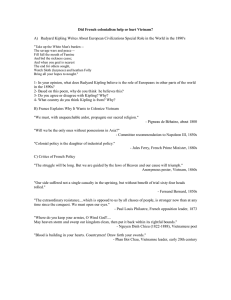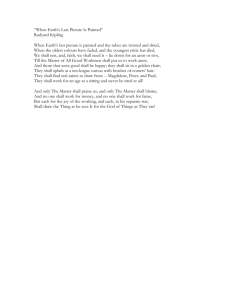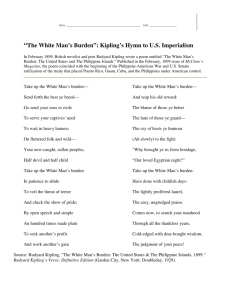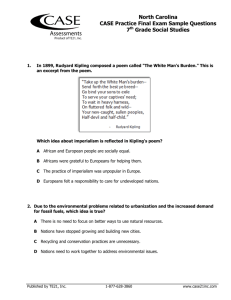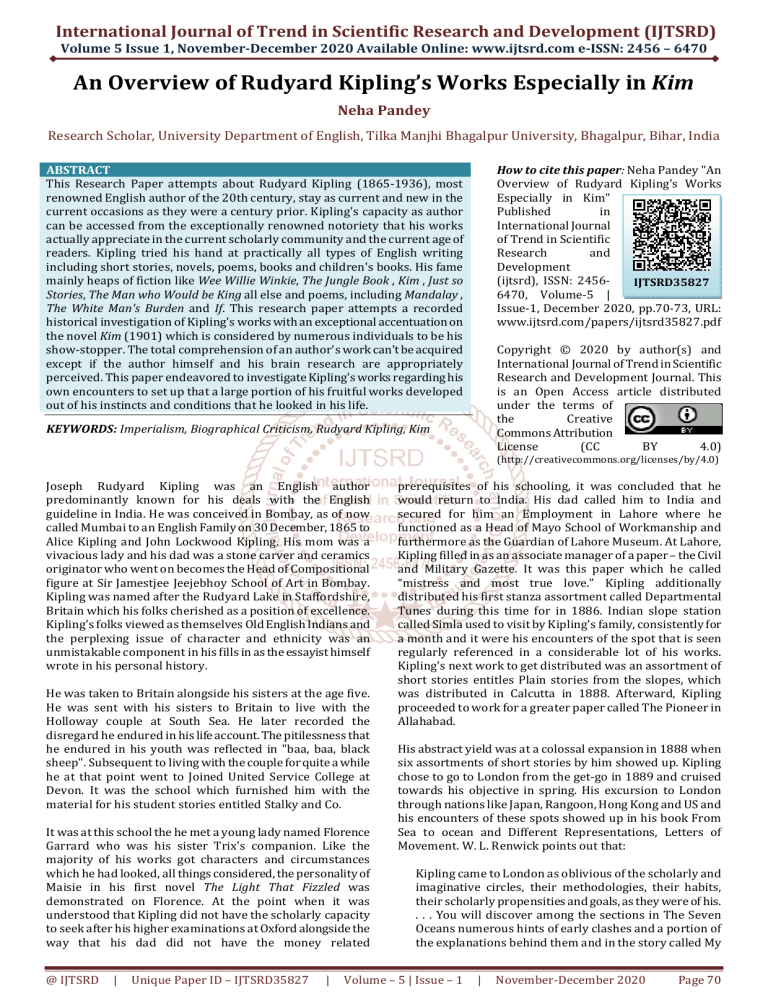
International Journal of Trend in Scientific Research and Development (IJTSRD) Volume 5 Issue 1, November-December 2020 Available Online: www.ijtsrd.com e-ISSN: 2456 – 6470 An Overview of Rudyard Kipling’s Works Especially in Kim Neha Pandey Research Scholar, University Department of English, Tilka Manjhi Bhagalpur University, Bhagalpur, Bihar, India How to cite this paper: Neha Pandey "An Overview of Rudyard Kipling’s Works Especially in Kim" Published in International Journal of Trend in Scientific Research and Development (ijtsrd), ISSN: 2456IJTSRD35827 6470, Volume-5 | Issue-1, December 2020, pp.70-73, URL: www.ijtsrd.com/papers/ijtsrd35827.pdf ABSTRACT This Research Paper attempts about Rudyard Kipling (1865-1936), most renowned English author of the 20th century, stay as current and new in the current occasions as they were a century prior. Kipling's capacity as author can be accessed from the exceptionally renowned notoriety that his works actually appreciate in the current scholarly community and the current age of readers. Kipling tried his hand at practically all types of English writing including short stories, novels, poems, books and children's books. His fame mainly heaps of fiction like Wee Willie Winkie, The Jungle Book , Kim , Just so Stories, The Man who Would be King all else and poems, including Mandalay , The White Man's Burden and If. This research paper attempts a recorded historical investigation of Kipling's works with an exceptional accentuation on the novel Kim (1901) which is considered by numerous individuals to be his show-stopper. The total comprehension of an author's work can't be acquired except if the author himself and his brain research are appropriately perceived. This paper endeavored to investigate Kipling's works regarding his own encounters to set up that a large portion of his fruitful works developed out of his instincts and conditions that he looked in his life. Copyright © 2020 by author(s) and International Journal of Trend in Scientific Research and Development Journal. This is an Open Access article distributed under the terms of the Creative Commons Attribution License (CC BY 4.0) KEYWORDS: Imperialism, Biographical Criticism, Rudyard Kipling, Kim (http://creativecommons.org/licenses/by/4.0) Joseph Rudyard Kipling was an English author predominantly known for his deals with the English guideline in India. He was conceived in Bombay, as of now called Mumbai to an English Family on 30 December, 1865 to Alice Kipling and John Lockwood Kipling. His mom was a vivacious lady and his dad was a stone carver and ceramics originator who went on becomes the Head of Compositional figure at Sir Jamestjee Jeejebhoy School of Art in Bombay. Kipling was named after the Rudyard Lake in Staffordshire, Britain which his folks cherished as a position of excellence. Kipling's folks viewed as themselves Old English Indians and the perplexing issue of character and ethnicity was an unmistakable component in his fills in as the essayist himself wrote in his personal history. He was taken to Britain alongside his sisters at the age five. He was sent with his sisters to Britain to live with the Holloway couple at South Sea. He later recorded the disregard he endured in his life account. The pitilessness that he endured in his youth was reflected in "baa, baa, black sheep". Subsequent to living with the couple for quite a while he at that point went to Joined United Service College at Devon. It was the school which furnished him with the material for his student stories entitled Stalky and Co. It was at this school the he met a young lady named Florence Garrard who was his sister Trix's companion. Like the majority of his works got characters and circumstances which he had looked, all things considered, the personality of Maisie in his first novel The Light That Fizzled was demonstrated on Florence. At the point when it was understood that Kipling did not have the scholarly capacity to seek after his higher examinations at Oxford alongside the way that his dad did not have the money related @ IJTSRD | Unique Paper ID – IJTSRD35827 | prerequisites of his schooling, it was concluded that he would return to India. His dad called him to India and secured for him an Employment in Lahore where he functioned as a Head of Mayo School of Workmanship and furthermore as the Guardian of Lahore Museum. At Lahore, Kipling filled in as an associate manager of a paper – the Civil and Military Gazette. It was this paper which he called “mistress and most true love.” Kipling additionally distributed his first stanza assortment called Departmental Tunes during this time for in 1886. Indian slope station called Simla used to visit by Kipling's family, consistently for a month and it were his encounters of the spot that is seen regularly referenced in a considerable lot of his works. Kipling's next work to get distributed was an assortment of short stories entitles Plain stories from the slopes, which was distributed in Calcutta in 1888. Afterward, Kipling proceeded to work for a greater paper called The Pioneer in Allahabad. His abstract yield was at a colossal expansion in 1888 when six assortments of short stories by him showed up. Kipling chose to go to London from the get-go in 1889 and cruised towards his objective in spring. His excursion to London through nations like Japan, Rangoon, Hong Kong and US and his encounters of these spots showed up in his book From Sea to ocean and Different Representations, Letters of Movement. W. L. Renwick points out that: Kipling came to London as oblivious of the scholarly and imaginative circles, their methodologies, their habits, their scholarly propensities and goals, as they were of his. . . . You will discover among the sections in The Seven Oceans numerous hints of early clashes and a portion of the explanations behind them and in the story called My Volume – 5 | Issue – 1 | November-December 2020 Page 70 International Journal of Trend in Scientific Research and Development (IJTSRD) @ www.ijtsrd.com eISSN: 2456-6470 Child's Better half and A Variety of Animals, a later and substantially less cheerful mentality to his kindred craftsmen. Kipling additionally thought of some shocking tales when he was youthful. The loathsomeness of things is seen in puzzling Bubbling Well Road, Bertran and Bimi where there is the half - human ape who out of desire revoltingly slaughters the proprietor's young spouse. The effect of his own brain science is seen in the greater part of his works and can be identified with his age and day to day environments. While in London he distributed a novel The Light That Failed and furthermore the novel The Naulahka, which he wrote as a team with the American author Wolcott Balestier. In 1892 Kipling wedded Balestier's sister Carrie in London. The couple went to US for their wedding trip and settled at a house named Bliss Cottage. It was at Bliss Cottage that Kipling composed The Jungle Books. The setting and the sort of climate needed for composing The Jungle Books was given by the house and in this way could be viewed as rising out of those particular circumstances which the author confronted. The family at that point moved to another place of named Naulakha out of appreciation for Wolcott. Kipling lived cheerfully there till the aggravation between UK and Venezuela over English Guiana emerged. The contest proceeded to turn into a significant Anglo-American emergency and Kipling felt awkward as an English resident in America as that time. Henceforth he chose to move out and go to England. By 1896, Kipling was back in England and settled at Devon, in the south England. It was here that Kipling composed his most popular sonnets like Recessional and The White Man's Burden. From that point he proceeded to visit South Africa and Sussex. Kipling was granted the esteemed Nobel Prize in Writing in 1907. He additionally remains the most youthful beneficiary of the honor to this date. The prize reference stated: "with regards to the intensity of perception, creativity of creative mind, virility of thoughts and astounding ability for portrayal which describe the manifestations of this world-acclaimed creator." Nobel prizes had been set up in 1901 and Kipling was the primary English-language beneficiary. The honor of being the British Poet Laureate and Knighthood were likewise proposed to him whom he purportedly declined or wouldn't acknowledge. In 1910 Kipling's story assortment Reward and Fairies was distributed which contained his most well known poem named If. Kipling referenced in his collection of memoirs that the poem was roused by Dr Leander Starr, who was the head of the development the Jameson Attack by British Forces against the Boers in South Africa. Jameson's life and the association with the sonnet are completely canvassed in the book The If Man: Dr Leander Starr Jameson, the Motivation for Kipling's Show-stopper by Chris Debris. An unmistakable Indian author Khushwant Singh wrote in 2001 that Kipling's If has "the substance of the message of The Gita in English." World War I broke out in 1914 and it saw Kipling supporting the UK's war points. Kipling despised untrustworthy men who needed activity and truthfulness towards their obligation in the First World War. He composed The New Army in Training in 1915, in a similar setting. Kipling's own child John passed on at the Battle of Loos in 1915 at eighteen @ IJTSRD | Unique Paper ID – IJTSRD35827 | years old. John's demise is by all accounts showed in the sonnet My Boy Jack written in 1916 and furthermore in the play My Boy Jack. Incompletely because of the misery brought about by his child's demise and mostly in any case, Kipling joined Sir Fabian Ware’s Imperial war Graves Commission. He additionally composed the historical backdrop of his child's regiment the Irish Guard in two volumes in 1923. His regular visits to the war graveyards brought forth the short story The Gardener and the sonnet The King’s Pilgrimage in 1922. The personal components in his works become clear when one returns to follow the birthplaces Kipling's works. The motivation generally originates from his life's functions and happenings. Kipling kicked the bucket of a punctured duodenal ulcer on 18 January, 1936, matured seventy. Kipling's standing has never mellowed down since. T.S. Eliot, a Nobel Prize Laureate himself altered – A Choice of Kipling's Section in 1943 and remarked that " Kipling could compose incredible verse on events – regardless of whether simply coincidentally", in this manner reviving the a distant memory essayist and furthermore strengthening that Kipling's best works rose up out of explicit events in his day to day existence. Kipling's prevalence has seen a few stages. By 1892 a few pundits talked about him as "written out" ; by 1909 he was presumably at his peak; in the nineteentwenties and thirties he was, if not overlooked, one whom to favor was to admit oneself external the pale of genuine understudies of writing. T. S. Eliot could compose of him as a "neglected celebrity”. Five years in the wake of Kipling's demise, H.E. Bates attracted matches among him and Hitler his 'adoration for the most lavish type of nationalism, showy stage impacts and perverted hatred for the accommodating'. Concerning his style it was totally named as ‘glitter and metal's’ by Bates. However, the reality remains that even the pundits who censure his work cannot get away from the sheer weight of his greatness. A model in the current case is Amit Chaudhuri, who had assaulted Kipling entirely in his work 'however later recognized that 'Kipling is an extraordinary author.' Another incredible essayist of the 20th century, Henry James said that "Kipling strikes me actually as the most complete man of virtuoso (as unmistakable from fine insight) that I have ever known." Kipling had been blamed for one thing over and over which is the imperialistic strain in his works. One of the significant essayists George Orwell went to the degree of considering him a "prophet of British imperialism". Alongside Government Kipling has been blamed for twistedness. Dr Henn, who comprehended the allegations on Kipling in detail and investigated his works, presumed that "his composing is at its best when he utilizes the mode of a person who talks in Pushtu, Urdu and even middle age latin." for example his oriental association. With this recognition Dr Henn sees Kim as the highest point of Kipling's accomplishment. Kim has in reality been viewed as Kipling's Magnum opus by numerous pundits. It turned out to be the first Indian PM Jawahar Lal Nehru's favourite book. It was explicitly in Kim that "Kipling has set up the difference between the East, with its supernatural quality and its erotic nature, its boundaries of righteousness and mischief, and the English, with their boss association, their trust in present day strategy, their sense to brush away like spider webs the local fantasies and convictions... we have viewed the motions of Kim, as he passes forward and backward between them (Wilson 30)." Volume – 5 | Issue – 1 | November-December 2020 Page 71 International Journal of Trend in Scientific Research and Development (IJTSRD) @ www.ijtsrd.com eISSN: 2456-6470 In the fall of 1899, having gotten done with Salky and Co., Kipling went again to Kim. As respects to the inception of the novel and the anecdotal viewpoints engaged with it, Kipling wrote: It developed like the Djinn delivered from the brass bottle, and the more we investigated its prospects the more richness of detail did us find. I do not have the foggiest idea what extent of a chunk of ice is beneath water-line, however Kim as it at long last showed up was around one-tenth of what the principal extravagant example called for . . . The Himalayas I painted all I, as the youngsters state. So, additionally the image of the Lahore Museum of which I had once been Deputy Curator for about a month and a half unpaid yet gigantically significant. (Kipling 139) The novel was at first distributed sequentially in McClure's Magazine from December 1900 to October 1901 just as in Cassell's Magazine in 1901. In Macmillan and Co. Ltd, Kim was first published in October 1901. The background of the novel is framed by the political clash among Russia and England, otherwise called The Great Game. With the political circumstance in the foundation the novel follows the excursion of an around thirteen years of age kid Kim, who is a chela or supporter to a Tibetan Teshoo Lama. It is a picaresque novel where both the preceptor and the supporter set out on an excursion across India: The lama in look for his stream of Arrow and Kim on his mission for a Red Bull in the Green fields. There is a definite picture of individuals and spots in India. "The eye is gotten by an entire kaleidoscope of race, rank, custom, and belief; all observed with warm warmth that is practically one of a kind in Kipling." Exhibition hall and is additionally some of the time alluded to as Kim's Gun. All through the novel Lama is in search from his Waterway of Bolt and Kim goes out in journey of a "Red bull in a green field" which is later observed as a military development indication of a bull on a green foundation. That arrangement sign is as yet utilized by a military development in Ambala Cantonment in India simply like the manner in which it has a place with a foundation in Ambala in the book. Kim has many mysterious components like the one showed in the character Huneefa who is a sorceress who plays out a villain conjuring custom to secure Kim. The explanation behind consideration of such spiritualist components in the novel can be found in Charles Carrington's explanation that "The craving to infiltrate the mysterious practiced a solid interest over Rudyard all through life, a fascination which he opposed, not inside and out effectively." It is the India of the start of 20th century that discovers its satisfactory picture in the novel. The perspectives on the essayist about India can be gotten a handle on from a line from the book, "Kim jumped into the cheerful Asiatic problem which, if just you permit time, will bring you all that a basic man requires." Partick Brantlinger focuses towards the personal component in the novel in the remark that, "In his best novel, he expounded on a kid whose satisfaction in 'cheerful Asiatic issue' coordinated his own." Further he brings up that "Among the entirety of Kipling's works, Kim best communicates the ethnographically inquisitive, open minded and in any event, respecting side of Kipling – that is, Kipling at his best. In spite of the fact that he (Kipling) called his work of art ‘nakedly picaresque and plot less’. . . . (138)” The personal components in the novel Kim are unmistakably found in the personality of the keeper of the Lahore Gallery which depends on Kim's dad John Lockwood Kipling who was a caretaker himself in Lahore. The extremely opening lines of the novel which run as: He sat, in defiance of municipal orders, astride the gun Zam-Zammah on her brick platform opposite the old Ajaib-Gher – the Wonder House, as the natives call the Lahore Museum. Who hold Zam-Zammah, that 'fire-breathing dragon', hold the Punjab, for the great green-bronze piece is always first of the conqueror's loot. (1) The weapon which is portrayed in these lines is a current piece called Zamzama which is arranged before the Lahore Numerous examinations have been made among Kim and E.M. Forster's A Passage to India because of the way that both the books are situated in India and both the essayists showed profound comprehension of the Indian culture. Nonetheless, in the assessment of Francis E Krishna , "there is no doubt as far as I can say that Kim is a more prominent work about India than Entry to India and my dispute is borne out by Nirad Chaudhuri and K.R.S. Iyenger just as various other Indian critics." While some consider Forster's understanding to be unrivaled and others the other way around, Thomas Humphrey Ward expresses that "He (Kipling) has given proof of information on Indian life which and its extraordinary in one so youthful." Kim shows Kipling's affectability towards India. Pundits have additionally attempted to discover the explanation behind more extensive prevalence of A Section to India among Indian readers or why Kim is or Kipling's works all in all stay uninitiated. @ IJTSRD | Unique Paper ID – IJTSRD35827 | J.M.S Tompkins brings up that in the specialty of Kim was one of the books the Daemon was worried in, that is, it was a work of motivation as recognized from one of distinct fascination and craftsmanship. It was ‘a thing imposed from without’, but no claim is made for it as a ‘built book’, and it is described as ‘nakedly picaresque and plot less’ (2). A fundamentally the same as view is held by Brander Matthews who composed that any place "his instinct was entire, as in Kim, in which the craftsman vanquishes the moralist and covers him profound underground, he is completely eminent: his images dress his instinct so we take it for fragile living creature and blood." Since numerous religions are appeared in the novel, many have attempted to examine which religion Kipling himself had confidence in. As respects the religion of Kipling Bonamy Dobree brings up "Yet the most superficial perusing of Kim shows the amount he regarded the confidence of the Lama; and in that book he talks hatefully of the Protestant parson, Bennett, who took a gander at the Lama" and calls him 'Heathen'." He finishes with a tenderly ironical touch at the dullness of the European guest, and his materialistic distractions. George Orwell has communicated the situation expressing while at the same time discussing Barrack Room Ballads that "How complete or honest an image has Kipling left us of the long help, soldier of fortune multitude of the late nineteenth century? One must state of this, as of what Kipling expounded on the nineteenth Century Anglo-Indian, that it is not simply the best however nearly the main artistic picture we have." There by featuring the significance of an author as Kipling who is considered as a dedicated writer of that age. Another critic has called attention to that portion of what gives Kim's take pleasure in India is its creator's trust in the rightness and lastingness of English Standard for example his confidence that shows in the content. Edward said writes in Culture and Imperialism that Kim possesses 'equal universes' so as to draw the similarity between Kipling's Volume – 5 | Issue – 1 | November-December 2020 Page 72 International Journal of Trend in Scientific Research and Development (IJTSRD) @ www.ijtsrd.com eISSN: 2456-6470 reality and Kim's. The epic has been taken up for conversation and study by different scholars and pundits and a large number of them have called attention to towards the royal strain in the present just as different works of Rudyard Kipling; particularly after the approach of the new writing. James Joyce once expressed that three authors of the nineteenth century who had the best common ability were Leo Tolstoy, D'Annunzio and Rudyard Kipling. He further expressed that every one of the three of the, has semi-fan thoughts regarding religion and energy. Kipling stays a top pick of numerous readers of English writing and a considerable lot of his peers as well. CONCLUSION Kipling was in reality a fabulous author whose works keep on being perused and investigated on. His own character has been viewed as mind boggling and mysterious. As per my investigation of his works and his memoir, I have firmly felt the component of personal history winning in his works. In spite of the fact that Kipling's works comprise of fiction and contain numerous incredible components however the individual component lies not in the story but rather behind the account for example its cause or the motivation that lay behind the composition of a bit of work. Kipling's works have needed to confront blended responses yet the allencompassing certainty remains that his popularity has not lessened. His works have been exceptional perceived considering his own encounters. An author cannot be disconnected from the time he lived and delivered in and such a wonder is difficult to be isolated from the works and life of Kipling. Kim stands apart from his works for the sheer magnificence of the otherworldly angle in the novel and the remarkable portrayal if India and its kin. His works have been adjusted and keep on holding hypnotizing control over its readers. They are the writers of history of nineteenth and mid 20th century and subsequently the verifiable setting turns into a noticeable portion of any examination completed on Kipling's works. REFERENCES [1] Birkenhead, Robin. Rudyard Kipling. Delhi: A Star Book, 1980. Print. Booth, Howard J, ed. The Cambridge Companion to Rudyard Kipling. United Kingdom: Cambridge University Press, 2011. Print. [2] Brantlinger, Patrick. “Kim”. The Cambridge Companion to Rudyard Kipling. ed. Howard J. Booth. United Kingdom: Cambridge University Press, 2011. Print. @ IJTSRD | Unique Paper ID – IJTSRD35827 | [3] Carrington, Charles. Rudyard Kipling: His life and work. London: Macmillan & Co. Ltd, 1955. Print. Dobree, Bonamy. Rudyard Kipling: Realist and Fabulist. London, New York, Toronto: Oxford University Press, 1967. Print. [4] Guerin, Wilfred L., et al. A Handbook of Critical Approaches to Literature. 5th ed. India: Oxford University Press, 1992. Print. [5] Henn, T.R. Kipling. Great Britain, Edinbugrh, London: Oliver and Boyd Ltd., 1967. Print. [6] "Kim". The Concise Oxford Companion to English Literature. Gen. Ed. Margaret Drabble and Jenny Stringer. United Kingdom: Oxford University Press, 2007. Print. [7] Kipling, Rudyard. Kim. London: Macmillan and Co. Ltd., 1948.Print. [8] Krishna, Francis E. Rudyard Kipling: His Apprenticeship. India: Print well Publishers Jaipur, 1988. Print. [9] ---. Life’s Handicap: Being stories of Mine Own People. London: Macmillan and Co., 1891. Print. [10] ---. Something of Myself. Cambridge: Cambridge University Press, 1991. Print. [11] ---. The Jungle Book. New York: Dover Publications, Inc., 2000. Print. [12] ---. The Seven Seas. South Carolina: Nabu Press LLC, 2010. Print. [13] Rutherford, Andrew, ed. Kipling’s Mind and Art: Selected Critical Essays. California: Stanford University Press, 1964. Print. [14] Rutherford, Andrew. General Preface to the Editions of Rudyard Kipling, in "Puck of Pook's Hill and Rewards and Fairies", by Rudyard Kipling. United Kingdom: Oxford University Press, 1987. Print. [15] The Modern Language Association of America. MLA Handbook for Writers of Research Papers. 7th ed. New Delhi: Rekha Printers Pvt. Ltd, 2009. Print. [16] Tompkins, J.M.S. The Art of Rudyard Kipling. London: Methuen & Co. Ltd., 1959. Print. [17] Trivedi, Harish. “Reading Kipling in India”. The Cambridge Companion to Rudyard Kipling. Ed. Howard J. Booth. United Kingdom: Cambridge University Press, 2011. Print. Volume – 5 | Issue – 1 | November-December 2020 Page 73
